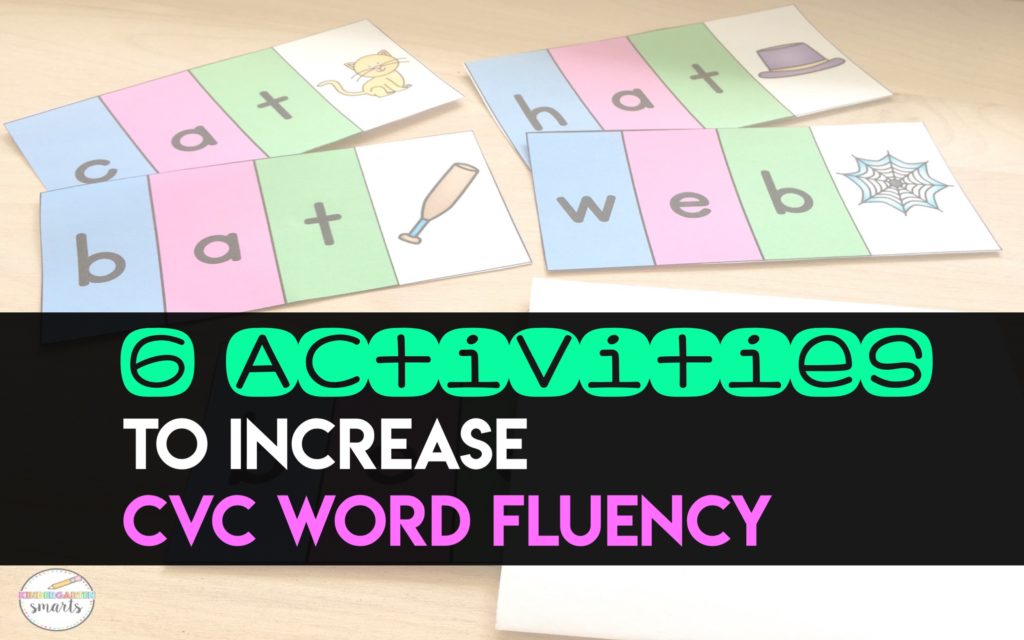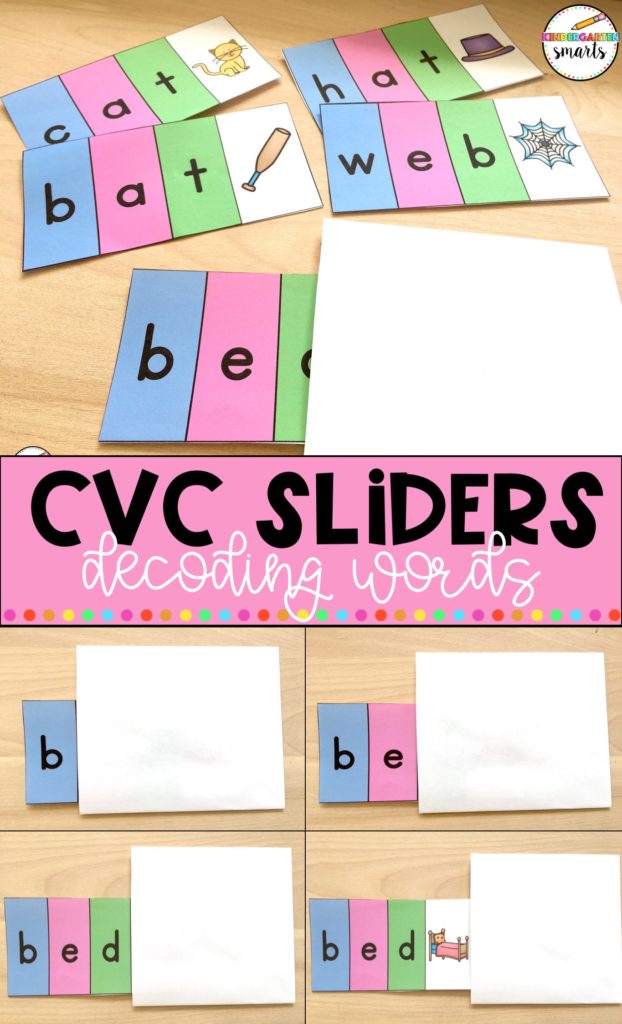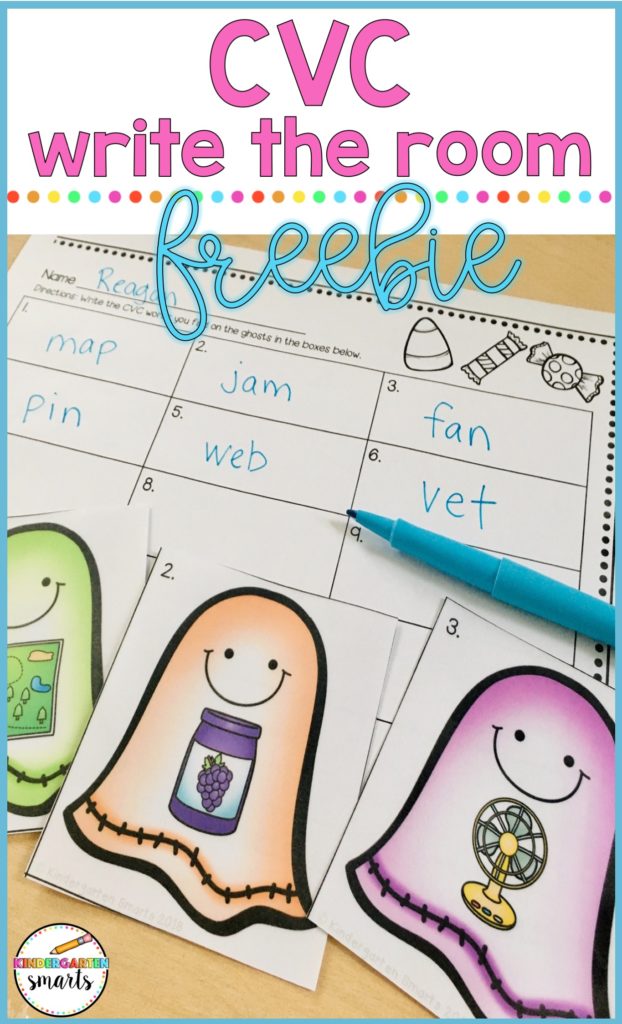
Teaching children to read and write CVC words doesn’t have to be challenging. If you follow some basic steps and give them meaningful ways to practice CVC words, they can become quite fluent in reading and writing CVC words. Here are some steps I have used over the years that work for me and my students.
1. Lines of Practice
A way to build fluency is to make strips of paper with 3 CVC words on it. I call this lines of practice. I do this during my guided reading group time. Each student will receive a strip of paper and their job is to read the words as I lean in and listen to each student. Some may still be decoding the words and some may be ready just to read the whole word. Again, when I group my students by ability they all seem to be on the same page when it comes to reading CVC words. After I have heard each student read their 3 words, they are to rotate their lines of practice to the next person. We repeat this until the rotation is complete.
2. Use CVC sliders to practice decoding
I love these CVC sliders!! They are great for isolating the sounds and breaking up each letter one at a time. When kids look at the entire word, it can be overwhelming, so hiding each letter and slowly revealing the next letter can be quite helpful to them. At the end of each word is a picture to help them put a picture to the word to make learning that much more concrete! These are also PERFECT for your English language learners. I use these CVC sliders during guided reading group time. I always differentiate my groups by ability too. Once my students have really mastered isolating the sounds, I then challenge them by exposing the entire word at once and see how fast they can read the whole word. This really builds up their fluency too.
3. Whole group fluency practice
I love to do this as a quick 1 min warm up.
- I write about 6-10 CVC words on my easel or white board, and depending on the time of year, I modify the fluency practice.
- When we first start decoding the words, I will put dots under each letter and then swipe my finger under all 3 letters for them to read the whole word.
- Once the majority of the class has mastered reading the whole word, I skip the decoding part, and we quickly go through and read the CVC words to practice our fluency.
This is always done whole group as a quick warm up, and nothing more. Of course I will have students who are struggling and not quite there yet, so I make sure to take note of them, and we work in a small group setting to get them up to speed. I believe it is important for even the struggling students to hear how we read words fluently, even if they aren’t quite ready to tackle this.
4. Practice onset and rhyme
Onset is the first sound in the word and the rhyme are the word families. I like to start first with all of the same word families such as -at. Once they become experts, then I mix it up more. I like to write down as many cvc words as I can that are in the same word family: sat, rat, fat, hat, mat, etc… for each word I place a dot under the onset and then make a curve/swooping motion to finish the rhyme. So it sounds like “/ssss/ at” and then after I swoop under the rhyme I run my finger under the whole word and read it. They start to focus on the word families and quickly blend the first sound with it. This starts to increase their fluency.
Aside from doing the onset and rhyme visually, I also like to do it as a quick oral warm up too. I’ll say, “lets blend to make a word…. /r/at”. They respond, “rat!” I do this with many different words and eventually mix up the word families so it’s not as predictable.
Another fun way to practice onset and rhyme is to use a visual cue such as a marker. The onset is the cap and the rest of the word is the base of the marker. I’ll show how I can remove the cap (aka the onset) and create a new word by changing the beginning sound. This is typically done when you keep the same word family.
For example: I’ll touch the cap of my marker and say “/m/” and then swipe my finger along the base of the marker and say “at” and the students will tell me the word they hear. I will then remove the cap and say, “now I’m going to change the /m/ sound to a /b/ sound, what’s the new word?” I do this until I can’t come up with anymore words from the same word family. It’s a fun way for them to see it visually!
5. CVC word building
I LOVE word building during a whole group lesson. This is an activity that I do ALL YEAR long, but tweak it depending on the skills being covered. To see how I conduct CVC word building, you can check out my post here!
To sum it up, students will practice writing CVC words on their own white boards while sitting on the carpet during a lesson. I use picture cards that match the CVC word to reinforce their learning as well as encourage them to put the words into a sentence. Because we do this process daily, it becomes routine and like clockwork! I used to have teachers from other schools come visit my classroom to see how I conducted word building. Believe me, it works! In the link above you can even see a live video of me conducting word building. So come check it out! Click here for the video.
6. CVC sentence practice
There’s no better way to improve CVC fluency than using these words in a sentence. One of my favorite cvc literacy centers is this!
Simply print and cut the strips and glue the CVC word bank on the front of an envelope. Students will use the CVC word bank (on the front of the envelope) to complete the sentence. These simple sentences are great for building fluency, handwriting, sentence structure, and decoding words. So many skills covered!
- Last but not least….. Come Grab this FREE CVC Write the Room Activity here!
Happy Teaching!!
Join the newsletter
Sign up for exclusive freebies and teaching tips here!






Leave a Reply